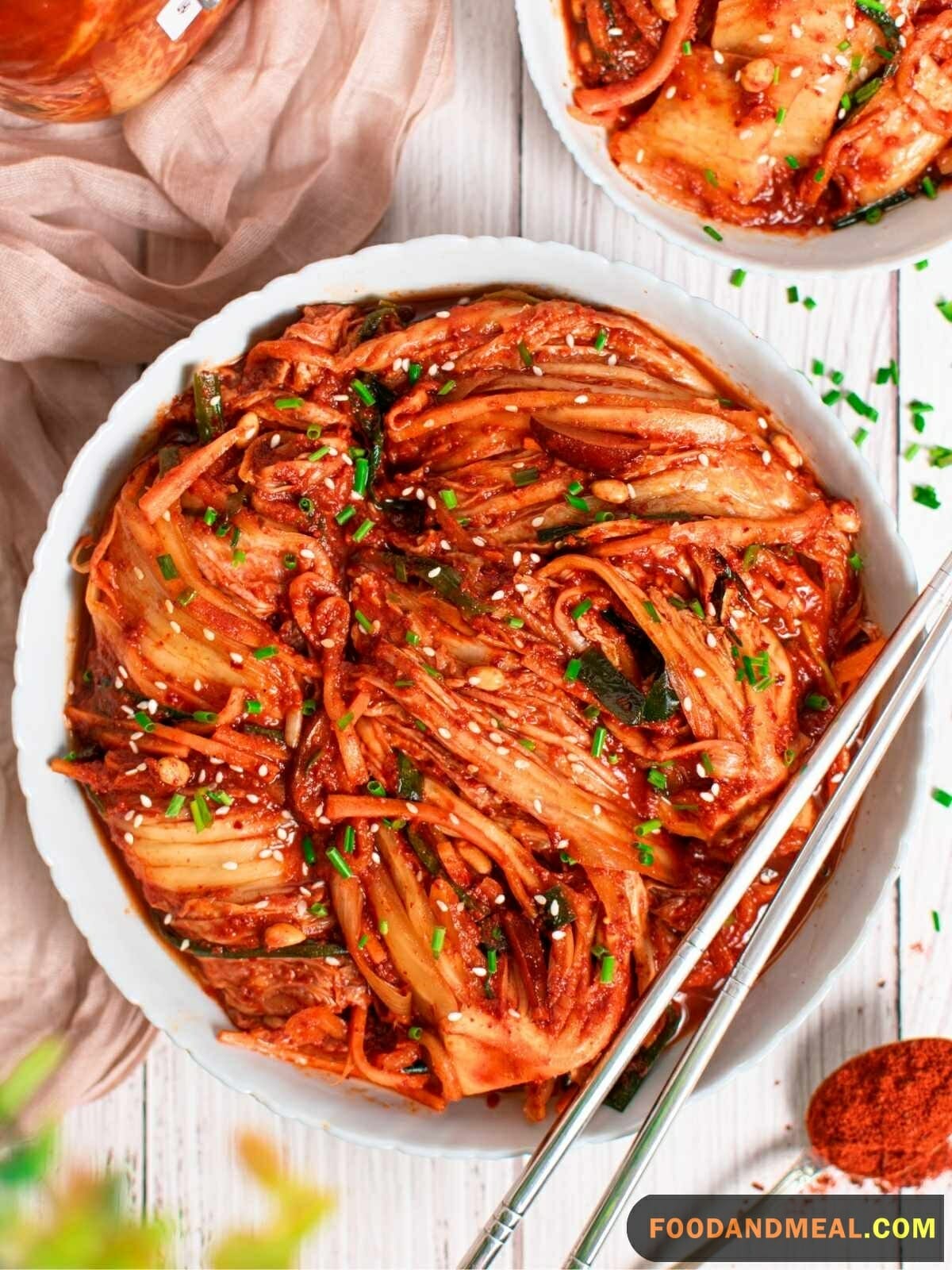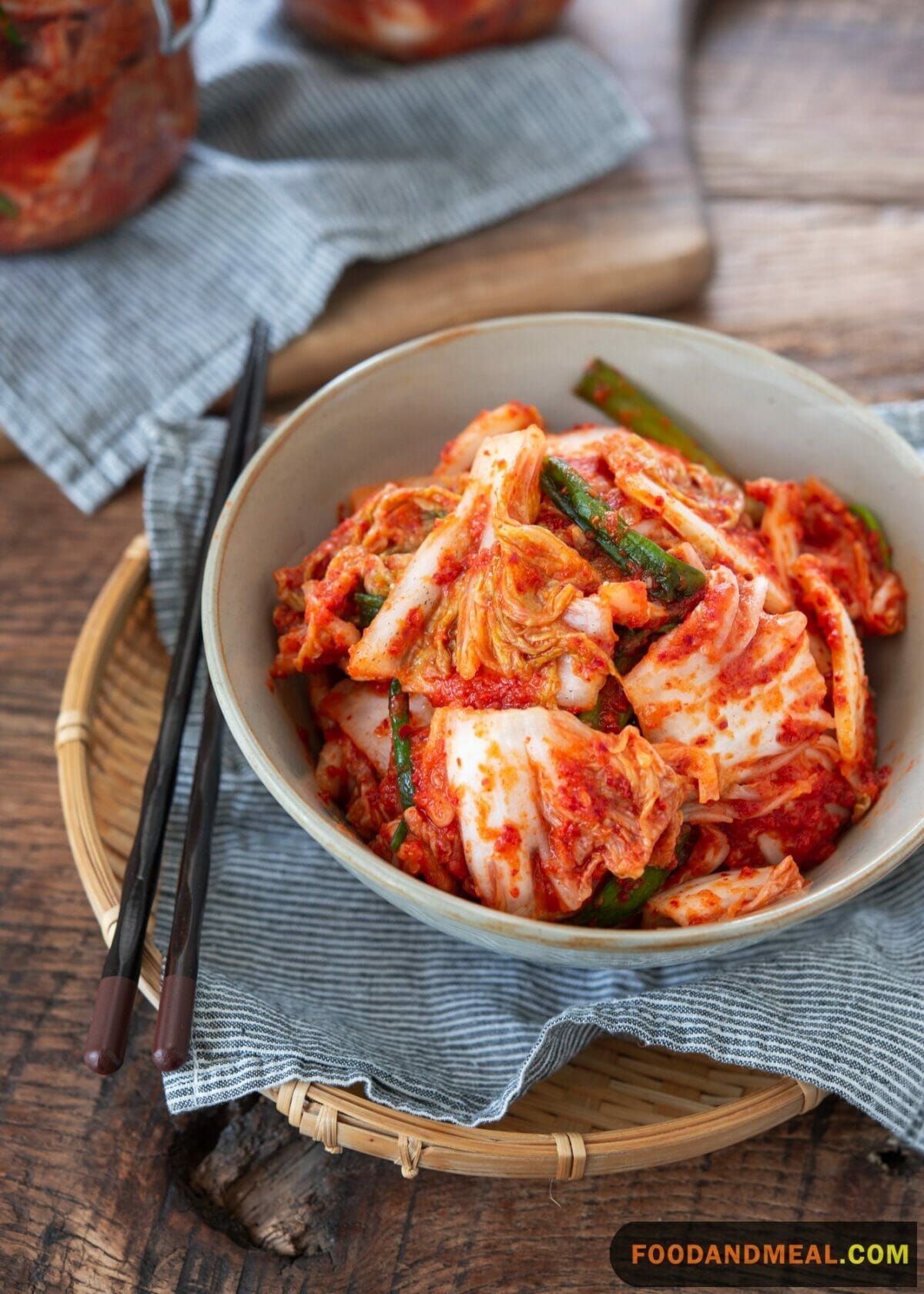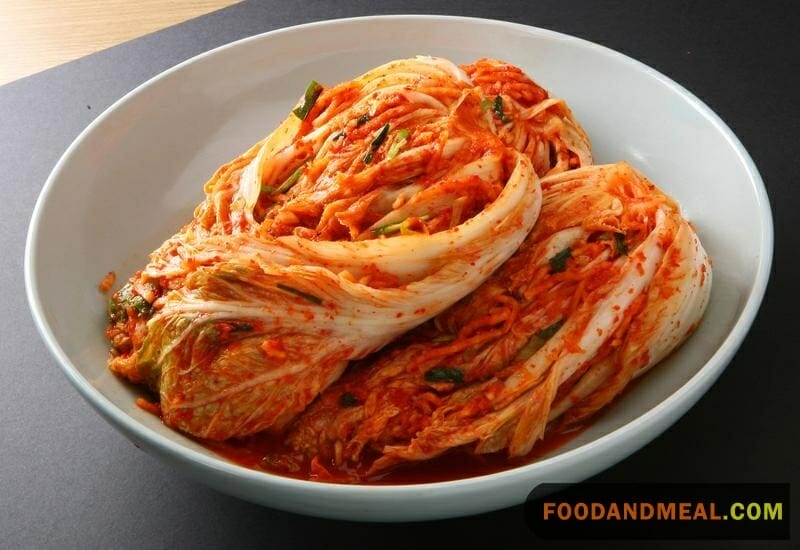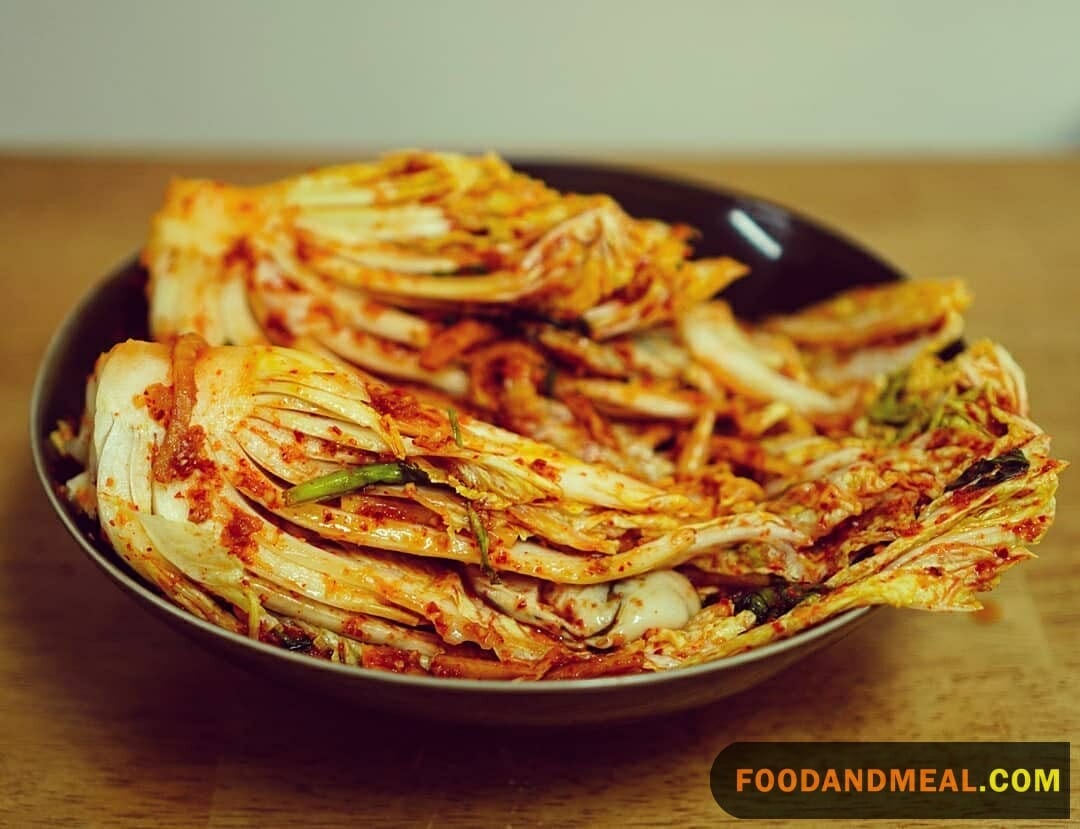I’m excited to share with you my recipe for Napa Cabbage Kimchi. As some of you may know, I work at Food and Meal where we create delicious recipes daily. However, this kimchi recipe comes straight from my heart and my Korean heritage.
Growing up, my grandmother would make huge batches of baechu kimchi every winter to stock our fridge for the upcoming year. I have vivid memories of helping her layer the salted cabbage leaves with the bright red chili paste, watching as she would mix in the garlic, ginger, fish sauce, and other magical ingredients. The whole house would be filled with the pungent, funky smell of fermenting kimchi.
As an adult living far from my grandmother, I often crave the taste of her homemade kimchi. The store-bought kinds just don’t compare. So, I decided to call her up and have her walk me through her tried and true family recipe. With her guidance and my trial-and-error, I finally perfected making kimchi that takes me back to my childhood.
The result is this easy-to-follow recipe for the most popular and beloved type of kimchi – baechu kimchi made with Napa cabbage. I improved on my grandmother’s recipe by experimenting with extra ginger and fish sauce to make it even more pungent and full of umami. I also added a touch of sugar to balance out the spiciness.
I hope you’ll enjoy this recipe as much as I love making it. The final product is a healthy, addicting side dish that pairs perfectly with rice, noodles, eggs, meat, and more. Let the cabbage ferment for at least 3 days to let the flavors develop fully. Feel free to adjust ingredients to suit your taste. Most importantly, have fun with it! Kimchi-making time is special bonding time with friends and family. I like listening to Korean ballads while mixing everything together with my hands – it makes me feel connected to my heritage.

Napa Cabbage Kimchi Recipe

NAPA CABBAGE KIMCHI
Ingredients
- 1 cup coarse sea salt
- 10 cups Water
- 2 heads napa cabbage, cut into 2-inch squares
- 1 tablespoon finely chopped garlic
- 1 tablespoon chopped ginger
- 1/2 cup gochugaru
- 2 tablespoons sugar
- 5 scallions, cut into 1⁄2-inch pieces
- 2 tablespoons fish sauce
Instructions
- In a very large nonreactive (such as glass, ceramic, or plastic) bowl or pot, stir the salt into the water until mixed.
- Add the cabbage to the salt water and, if necessary, weigh down with large plate so all of the leaves are completely submerged. Marinate the cabbage for 5 to 6 hours.
- Remove the cabbage, discarding the marinating liquid, and rinse it in cold water. Squeeze out any excess liquid.
- In a very large bowl, mix the garlic, ginger, gochugaru, sugar, scallions, and fish sauce. Add the cabbage to the bowl and toss to coat with the seasoning mixture.
- Pack the seasoned cabbage into a large, airtight jar. Leave at least 4 to 5 inches at the top to allow for expansion during the fermentation process.
- Let the kimchi ferment in a cool, dark place (such as a shady corner or countertop) for 2 to 3 days before serving or refrigerating.
- Store in the refrigerator in an airtight container for up to 6 months.
Video
Notes
- Ingredient Quality: The star of Napa Cabbage Kimchi is, undoubtedly, the cabbage itself. Opt for the freshest, crunchiest Napa cabbage you can find. It's the foundation of incredible flavor.
- Fermentation Finesse: Patience is your ally when it comes to fermentation. Allow your kimchi to develop its flavors over time. Taste it daily to witness the transformation and find the sweet spot of tanginess.
- Versatility Galore: Napa Cabbage Kimchi isn't just a side dish – it's a versatile ingredient that can elevate countless dishes. Think beyond the kimchi bowl and explore creative ways to incorporate it into your meals.
Nutrition
© Food And Meal
This website provides approximate nutrition information for convenience and as a courtesy only. Nutrition data is gathered primarily from the Spoonacular Database, whenever available, or otherwise other online calculators.
Cooking Tips

Making kimchi is a rewarding process that demands time and patience, but the end result is undoubtedly worth the effort. To ensure your kimchi achieves perfect fermentation and is bursting with deliciousness, follow these key tips. Begin by thoroughly massaging the paste into the cabbage leaves, ensuring each one is generously coated for a deep flavor infusion. Opt for fresh, high-quality ingredients, as the excellence of the cabbage and spices directly influences the final product. During fermentation, keep the kimchi at a cool room temperature, preferably near a window with indirect sunlight, and monitor it daily. Exercise patience and resist the temptation to sample it too soon; a minimum of 3 days is necessary for the flavors to fully develop. Choose a container with ample space for expansion, as gases build up during fermentation, causing the kimchi to expand. If you’re new to intense flavors, savor kimchi in moderation at first, starting with a small side dish to fully appreciate its unique taste.
Serving suggestions

My Napa Cabbage Kimchi proves to be an exceptional companion to a variety of Asian dishes, enhancing their flavors with its spicy and tangy profile. For those seeking culinary inspiration, consider pairing this delectable kimchi with some of my favorite accompaniments. Gyoza, the Japanese pan-fried dumplings filled with pork and vegetables, harmonize perfectly as the kimchi cuts through the rich, fatty stuffing. Yakisoba, a quick Japanese noodle stir fry, gains vibrancy with the addition of sharp kimchi to balance the salty noodles. Karaage, irresistibly addictive Japanese fried chicken nuggets, find equilibrium with the acidity of kimchi cutting through their crispy richness. Oyakodon, a comforting Japanese rice bowl featuring chicken, egg, onions, and dashi broth, benefits from the spice and crunch of kimchi. Katsudon, another iconic Japanese rice bowl with breaded pork cutlet, attains a beautiful contrast as sweet and sour kimchi cuts through the hearty fried pork. Yaki Udon, a stir-fry of thick udon noodles with veggies and meat, gains a nice tangy contrast with kimchi. Enhance a traditional Miso Soup with kimchi and tofu for added substance and kick. These serving suggestions aim to inspire you to create delightful Asian fusion meals using my Napa Cabbage Kimchi.
Frequently Asked Questions of Napa Cabbage Kimchi

- Is Napa Cabbage Kimchi spicy? Can I adjust the heat? Yes, kimchi is known for its spiciness, but you have full control over the heat. Adjust the amount of red pepper flakes to your liking for a milder or spicier version.
- How long does Napa Cabbage Kimchi last? How should I store it? Properly stored in an airtight container in the refrigerator, Napa Cabbage Kimchi can last for several months, with the flavors maturing over time.
- Can I make a vegan version of Napa Cabbage Kimchi? Absolutely! Skip the fish sauce and opt for a soy sauce or tamari substitute to keep the umami intact.
- Can I use pre-cut cabbage for making kimchi? Pre-cut cabbage can be used, but it’s best to cut it yourself for better control over the size and texture of the leaves.
- What do I do with leftover kimchi juice? Can I use it in cooking? Absolutely! Kimchi juice is a flavorful marinade that can enhance various dishes. Use it to season soups, stews, or even marinades for proteins.
- Is Napa Cabbage the same as kimchi? No, Napa cabbage is the main vegetable used to make kimchi. Kimchi is a traditional Korean dish that involves fermenting Napa cabbage with a spicy seasoning mixture.
- How long to soak Napa cabbage for kimchi? Soak Napa cabbage in a brine solution for 1-2 hours during the preparation of kimchi. This helps to soften the leaves and prepare them for the seasoning process.
- How do you pick Napa cabbage for kimchi? Choose Napa cabbage heads that are firm, dense, and have tightly packed leaves. Look for fresh, vibrant green color with minimal wilting or browning. The cabbage should feel heavy for its size.
- How do you cut Napa cabbage for kimchi? To cut Napa cabbage for kimchi, halve the cabbage lengthwise, and then cut each half into bite-sized pieces. Ensure the cuts are of uniform size for even seasoning and fermentation.
Conclusion
I hope you’ve enjoyed this Napa Cabbage Kimchi recipe as much as I’ve enjoyed sharing it with you. As I mentioned at the start, I work at Food and Meal where we develop recipes daily. However, this one comes straight from my family traditions and connection to my Korean background.
I’m so happy to pass along my improved version of my grandmother’s kimchi for you to make and enjoy at home. The final result is a healthy, probiotic-rich side dish that perfectly accompanies any Asian-inspired meal. Feel free to adjust and experiment with ingredients over time to customize it to your personal tastes.
If you try this recipe, I’d love to hear your feedback over on the Food and Meal website or social media channels! Please tag @foodandmeal and let the community know how it turned out. Also let me know if you have any other Korean recipe requests – it motivates me to develop more of my family dishes to share on the blog.
I’m endlessly grateful I can maintain my bond to my heritage through cooking dishes like Napa Cabbage Kimchi. Food is so much more than sustenance – it’s culture, tradition, family, and love all wrapped into one. I hope everyone gives kimchi-making a try at least once. The hands-on process is very rewarding.
Hi! I'm Nazia of ‘Nazia Cooks’, a self-taught baker and cook residing in Chennai. Rooted in the rich South Indian culinary landscape, my palate has expanded to embrace global flavors. I revel in crafting fusion dishes, melding traditions to birth unique tastes.



